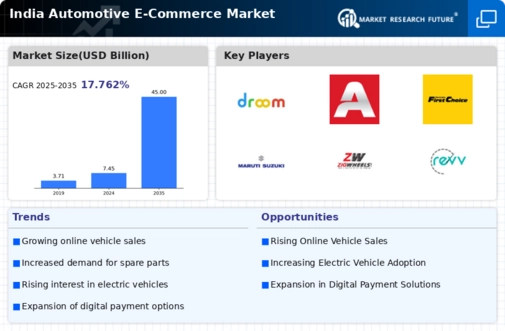Market Growth Projections
The Global India Automotive E-Commerce Market Industry is poised for remarkable growth, with projections indicating a market size of 12.5 USD Billion in 2024 and an anticipated increase to 45 USD Billion by 2035. This growth trajectory suggests a compound annual growth rate of 12.35% from 2025 to 2035, reflecting the increasing adoption of online automotive sales and services. The convergence of technological advancements, changing consumer preferences, and supportive government policies is likely to create a robust ecosystem for e-commerce in the automotive sector.
Rising Digital Penetration
The Global India Automotive E-Commerce Market Industry is experiencing a surge in digital penetration, driven by increasing internet access and smartphone usage. As of 2024, approximately 800 million people in India are expected to have internet access, facilitating online vehicle purchases and services. This digital shift allows consumers to compare prices, read reviews, and make informed decisions from the comfort of their homes. The convenience of online platforms is likely to attract a broader demographic, including younger consumers who prefer digital transactions. This trend is expected to contribute significantly to the market's projected growth, reaching 12.5 USD Billion in 2024.
Expansion of E-Commerce Platforms
The Global India Automotive E-Commerce Market Industry is witnessing the rapid expansion of e-commerce platforms dedicated to automotive sales. Major players are investing in user-friendly websites and mobile applications that enhance the shopping experience. These platforms often provide features such as virtual showrooms, detailed vehicle specifications, and customer reviews, which are crucial for informed decision-making. The competitive landscape is intensifying, as new entrants and established companies alike strive to capture market share. This expansion is expected to drive the market's growth, with a compound annual growth rate of 12.35% projected from 2025 to 2035.
Increased Focus on Sustainability
Sustainability is becoming a key driver in the Global India Automotive E-Commerce Market Industry, as consumers increasingly prioritize eco-friendly options. The rise of electric vehicles and sustainable automotive products is influencing purchasing decisions. E-commerce platforms are adapting by offering a wider range of green products and services, catering to the environmentally conscious consumer. This shift not only aligns with global sustainability goals but also opens new avenues for market growth. As the demand for sustainable automotive solutions rises, the market is expected to expand significantly, potentially reaching 45 USD Billion by 2035.
Government Initiatives and Support
Government initiatives aimed at promoting digital transactions and e-commerce are playing a pivotal role in the Global India Automotive E-Commerce Market Industry. Policies that encourage startups and technological innovation are fostering a conducive environment for online automotive sales. Additionally, the government's push for a digital economy is likely to enhance consumer trust in online platforms. These initiatives may lead to increased investments in technology and infrastructure, further propelling market growth. As a result, the industry is poised for substantial expansion, with projections indicating a market value of 12.5 USD Billion by 2024.
Growing Consumer Preference for Online Shopping
Consumer behavior is evolving, with a notable shift towards online shopping in the Global India Automotive E-Commerce Market Industry. The convenience of purchasing vehicles and automotive products online appeals to a wide range of consumers. This trend is evidenced by the increasing number of online platforms offering comprehensive vehicle listings, financing options, and home delivery services. As consumers seek hassle-free experiences, the market is projected to grow significantly, with estimates suggesting it could reach 45 USD Billion by 2035. This shift indicates a long-term transformation in how consumers engage with automotive products and services.














